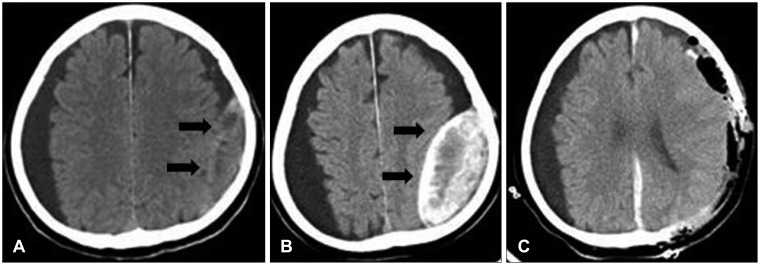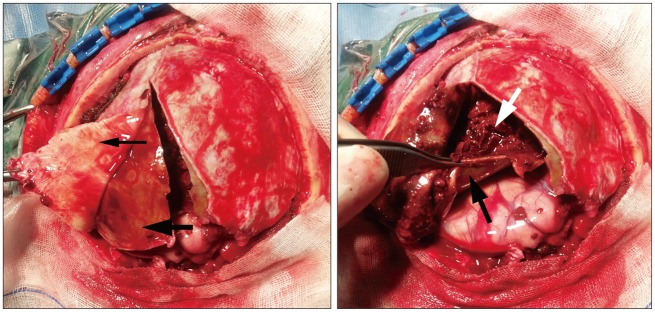Korean J Neurotrauma.
2014 Oct;10(2):142-145. 10.13004/kjnt.2014.10.2.142.
Encapsulated Unresolved Subdural Hematoma Mimicking Acute Epidural Hematoma: A Case Report
- Affiliations
-
- 1Department of Neurosurgery, Presbyterian Medical Center, University of Seonam College of Medicine, Jeonju, Korea. hisarang@hanmail.net
- KMID: 2256254
- DOI: http://doi.org/10.13004/kjnt.2014.10.2.142
Abstract
- Encapsulated acute subdural hematoma (ASDH) has been uncommonly reported. To our knowledge, a few cases of lentiform ASDH have been reported. The mechanism of encapsulated ASDH has been studied but not completely clarified. Encapsulated lentiform ASDH on a computed tomography (CT) scan mimics acute epidural hematoma (AEDH). Misinterpretation of biconvex-shaped ASDH on CT scan as AEDH often occurs and is usually identified by neurosurgical intervention. We report a case of an 85-year-old man presenting with a 2-day history of mental deterioration and right-sided weakness. CT scan revealed a biconvex-shaped hyperdense mass mixed with various densities of blood along the left temporoparietal cerebral convexity, which was misinterpreted as AEDH preoperatively. Emergency craniectomy was performed, but no AEDH was found beneath the skull. In the subdural space, encapsulated ASDH was located. En block resection of encapsulated ASDH was done. Emergency craniectomy confirmed that the preoperatively diagnosed AEDH was an encapsulated ASDH postoperatively. Radiologic studies of AEDH-like SDH allow us to establish an easy differential diagnosis between AEDH and ASDH by distinct features. More histological studies will provide us information on the mechanism underlying encapsulated ASDH.
MeSH Terms
Figure
Reference
-
1. Friede RL. Incidence and distribution of neomembranes of dura mater. J Neurol Neurosurg Psychiatry. 1971; 34:439–446. PMID: 5096558.
Article2. Friede RL, Schachenmayr W. The origin ofsubdural neomembranes. II. Fine structural of neomembranes. Am J Pathol. 1978; 92:69–84. PMID: 686149.3. Kawano N, Endo M, Saito M, Yada K. [Origin of the capsule of a chronic subdural hematoma--an electron microscopy study]. No Shinkei Geka. 1988; 16:747–752. PMID: 3412561.4. Killeffer JA, Killeffer FA, Schochet SS. The outer neomembrane of chronic subdural hematoma. Neurosurg Clin N Am. 2000; 11:407–412. PMID: 10918009.
Article5. Lee KS. Natural history of chronic subdural haematoma. Brain Inj. 2004; 18:351–358. PMID: 14742149.6. Miki S, Fujita K, Katayama W, Sato M, Kamezaki T, Matsumura A, et al. Encapsulated acute subdural hematoma mimicking acute epidural hematoma on computed tomography. Neurol Med Chir (Tokyo). 2012; 52:826–828. PMID: 23183078.
Article7. Oh HJ, Lee KS, Shim JJ, Yoon SM, Yun IG, Bae HG. Postoperative course and recurrence of chronic subdural hematoma. J Korean Neurosurg Soc. 2010; 48:518–523. PMID: 21430978.
Article8. Park HR, Lee KS, Shim JJ, Yoon SM, Bae HG, Doh JW. Multiple Densities of the Chronic Subdural Hematoma in CT Scans. J Korean Neurosurg Soc. 2013; 54:38–41. PMID: 24044079.
Article9. Prieto R, Pascual JM, Subhi-Issa I, Yus M. Acute epidural-like appearance of an encapsulated solid non-organized chronic subdural hematoma. Neurol Med Chir (Tokyo). 2010; 50:990–994. PMID: 21123983.10. Su IC, Wang KC, Huang SH, Li CH, Kuo LT, Lee JE, et al. Differential CT features of acute lentiform subdural hematoma and epidural hematoma. Clin Neurol Neurosurg. 2010; 112:552–556. PMID: 20483531.
Article11. Yamashima T, Yamamoto S. How do vessels proliferate in the capsule of a chronic subdural hematoma? Neurosurgery. 1984; 15:672–678. PMID: 6209593.
Article12. Yatsuzuka H. [Growing factors of chronic subdural hematoma--significance of CK activity in hematoma contents and neomembrane]. No To Shinkei. 1988; 40:963–969. PMID: 3196500.
- Full Text Links
- Actions
-
Cited
- CITED
-
- Close
- Share
- Similar articles
-
- Intraoperative Development of Contralateral Subdural Hematoma during Evacuation of Acute Subdural Hematoma: Case Report
- Postoperative Contralateral Supra- and Infratentorial Acute Epidural Hematoma after Decompressive Surgery for an Acute Subdural Hematoma: A Case Report
- Bilateral Acute Subdural Hematoma Following Evacuation of Chronic Subdural Hematoma
- Spontaneously Rapid Resolution of Acute Subdural Hemorrhage with Severe Midline Shift
- Acute Cervical Subdural Hematoma with Quadriparesis after Cervical Transforaminal Epidural Block




